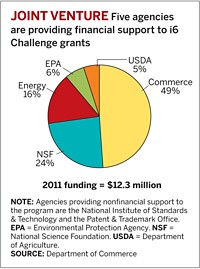Advertisement
Grab your lab coat. Let's get started
Welcome!
Welcome!
Create an account below to get 6 C&EN articles per month, receive newsletters and more - all free.
It seems this is your first time logging in online. Please enter the following information to continue.
As an ACS member you automatically get access to this site. All we need is few more details to create your reading experience.
Not you? Sign in with a different account.
Not you? Sign in with a different account.
ERROR 1
ERROR 1
ERROR 2
ERROR 2
ERROR 2
ERROR 2
ERROR 2
Password and Confirm password must match.
If you have an ACS member number, please enter it here so we can link this account to your membership. (optional)
ERROR 2
ACS values your privacy. By submitting your information, you are gaining access to C&EN and subscribing to our weekly newsletter. We use the information you provide to make your reading experience better, and we will never sell your data to third party members.
Policy
NIST Plays For High Stakes
New program for high-risk research is poised to award first grants, but future funding is unclear
by Rochelle Bohaty
July 21, 2008
| A version of this story appeared in
Volume 86, Issue 29

SMALL AND MEDIUM-sized U.S. companies, as well as universities and nonprofit organizations, pursuing high-risk research have a new path to federal funding in the Technology Innovation Program (TIP) of the National Institute of Standards & Technology (NIST). The program will award financial support for up to nine projects in the fall, but funding beyond 2008 is uncertain.
TIP replaces NIST's embattled Advanced Technology Program (ATP), which the Bush Administration eliminated last year. The new program, which is similar in some ways to ATP, supports U.S. innovation by funding high-risk research, but TIP requires that projects be focused on areas of critical national need. As part of the legislation that established TIP in 2007, ongoing ATP programs can continue to receive support under TIP.
"The key thing to understand is that TIP is not ATP. It is a new and different program, with different goals," TIP Program Director Marc G. Stanley emphasizes when asked to compare them. The differences remove some of the sticking points the Administration cited when justifying its efforts to phase out ATP.
For example, the focus of research supported by the programs is different. ATP was an industry-driven program supporting high-risk research that promised economic gains and widespread societal benefits, according to NIST. And NIST did not mandate the specific topic of projects. TIP, on the other hand, supports high-risk projects targeting areas of critical national need, which Stanley loosely identified in an April 23 webcast to include energy, water, communication networks, personalized medicine, and civil infrastructure.
Stanley tells C&EN that TIP projects will be technically challenging, revolutionary, or too novel or spanning too many disciplines to fare well in the traditional peer review process, and they must tackle key societal challenges that require government attention due to their enormity and complexity.
Like its predecessor, TIP will provide a cost-sharing opportunity for small and medium-sized U.S. companies. But unlike ATP, TIP opens the door to government laboratories, nonprofit research institutes, and consortia. TIP also prohibits support for larger companies, which may help the program avoid being labeled as corporate welfare. This criticism plagued ATP.
Universities and other academic institutions can also lead a joint venture seeking TIP funding as long as the collaboration includes a small or medium-sized business. Large companies can participate as unfunded partners of a joint venture. The program permits intellectual property rights resulting from TIP-sponsored research to be shared with any of the partners.
Awards made under TIP are not to exceed 50% of the project's total direct costs and are limited to $3 million over three years for solo ventures or $9 million over five years for joint ventures.
Congress has appropriated $65.2 million for TIP in fiscal 2008. However, most of the appropriated funds will support previous ATP awards. Nevertheless, Stanley points out that "approximately $9 million is available for TIP awards in 2008, equating to nine awards based on an estimated average first-year funding of $1 million per award."
WITH MONEY AVAILABLE for new awards, NIST announced on July 9 that it is now seeking proposals to develop technology for inspecting, monitoring, and evaluating critical components of the nation's roadways, bridges, and drinking and wastewater systems. The deadline for this year's competition is Sept. 4, and if all goes according to plan, the first project selections under the new TIP program will be made by late November, Stanley says.
For years, the Bush Administration tried to phase out ATP, which funded projects for 17 years. The program enjoyed significant congressional support and provided cost-sharing funds to 824 projects, including 56 awards issued last year. Assuming that all ongoing ATP projects are funded under TIP through completion, ATP projects will continue through 2011.
It is unfortunate that ATP was eliminated, says Glenn Batchelder, president and chief executive officer of BIND Biosciences. In 2007, BIND received ATP funding to develop a commercial research platform to generate a new class of targeted therapeutics using multifunctional nanoparticles. The company is using the award to translate an academic laboratory technology to a feasible commercial product.
"ATP uniquely filled a critical need for bridging the development between cutting-edge academic research and commercially viable technologies," Batchelder says. "ATP funding not only allowed us to invest in advancing our platform but also provided a level of validation that helped secure additional venture funding to advance" our project, he adds.
Funding for committed ATP awards and new TIP projects beyond 2008 is unclear, however, so it appears that TIP will inherit ATP's funding challenges at least until a new Administration takes office. President George W. Bush's budget request for 2009 does not include any funding for the new program.



Join the conversation
Contact the reporter
Submit a Letter to the Editor for publication
Engage with us on Twitter